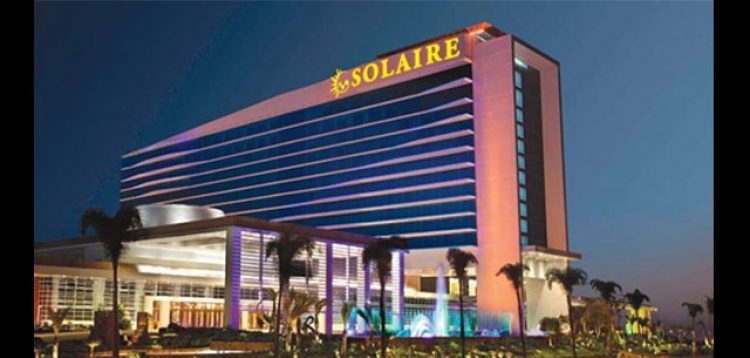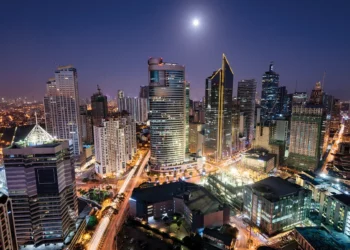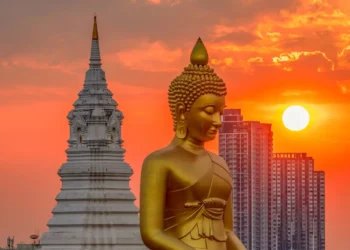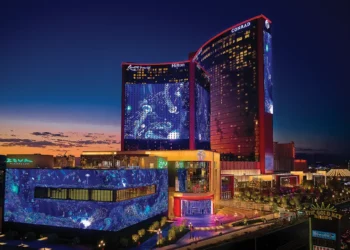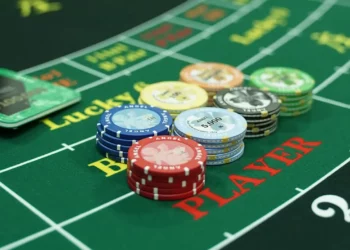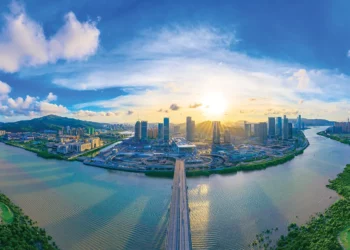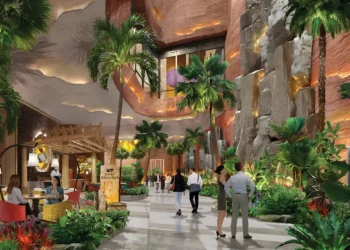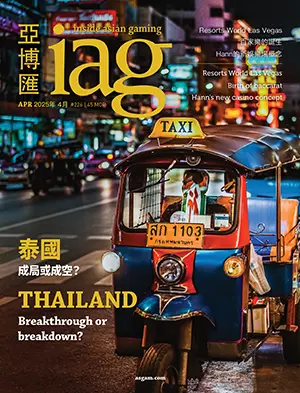Solaire Resort & Casino opened at Manila’s Entertainment City last month with a physical plant unlike anything the Philippines has seen and maybe just what it’s been waiting for
It was Friday, 15th March, the US$750 million first phase of Manila’s Solaire Resort & Casino was going to open in 24 hours, and dozens of men and women were working through the steamy afternoon to put the finishing touches on the outdoor backdrop and the lighting and sound effects where President of the Republic Benigno Aquino III would be officiating the next day.
Not far away, just out of earshot of the hammers and cranes, across an empty field and down the wide, empty expanse of Aseana Avenue, a street so new the virgin asphalt bears no lane markings, Lawrence Ho and James Packer, co-chairmen of Melco Crown Entertainment, had brought together the Chinese and Australian ambassadors under the leaden sky for an “officiating ceremony” in honor of Belle Grande Manila Bay, Solaire’s $1.3 billion rival whose opening is more than a year away.
Not a card had been dealt at that point at Bagong Nayong Pilipino Entertainment City, not a wheel spun or a drink poured, not a limo in sight, and already the game was on.
It’s a game the government eagerly awaits as it looks to Entertainment City—120 hectares of reclaimed flatlands along Manila Bay at the southwestern tip of the teeming capital city—to be the place where the Philippines is transformed into a destination of choice for Asia’s increasingly affluent and leisure-hungry masses, its own included. Tourism is a big deal in this island nation of 96 million, accounting for 10% of employment in a country where services generate 55% of annual GDP and the jobless rate hovers stubbornly at around 7%, the highest in Southeast Asia and more than double the average for the region. There were 4.2 million tourist arrivals in 2012. The government’s goal is 10 million by 2016. This would boost the sector’s share of total employment to more than 18%. The difference will be about 3.6 million jobs, according to government projections.
Solaire has created some 4,500 of those jobs at start-up, more than 400 of them returnees from the great Filipino diaspora routed straight into management for their skills and experience in gaming and hospitality in Macau, Singapore, Southeast Asia and the Arabian Peninsula.
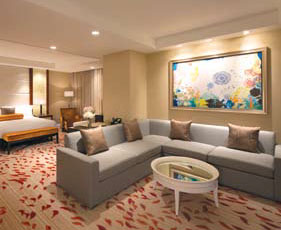
A sampling of Solaire’s spacious room product.
There is, then, something distinctly celebratory about this vision that sees vast fortunes plowed into Entertainment City with casinos as the catalyst, four of them, as currently envisioned, each at a government mandated minimum investment of $1 billion.
Solaire, which opened right on schedule that Saturday, the 16th of March, is the first, and as visions go it is inspired. Renowned casino architect Paul Steelman outdid himself to create an elegantly contemporary resort bathed in natural light that seems to thoroughly enjoy its ability to surprise you with panoramic bay-front views at unexpected turns. The 18,500-square-meter casino is constructed on two levels, VIP above, main floor below. It features 1,200 of the latest slot machines and 295 table games, 95 of them VIP. The adjoining parking garage is a Vegas-sized affair with a current capacity of 1,700 vehicles. The hotel contains 407 rooms labeled “Deluxe,” each a generous 43 square meters—king-size bed, spacious bath with separate rain shower, mini-bar, 46-inch flat-screen TV, wi-fi and iPod dock, 24-hour room service all standard. The 41 “Grand Deluxe” rooms weigh in at 52-57 square meters. Twenty-six suites top out at 94 square meters, all with bay views. Four “Bayside Villas” approximate the size of a suburban family’s home, the largest, the “Chairman’s,” at 936 square meters has its own swimming pool and fitness room and resident chef.
“He didn’t want to do something cheap. His voice was to build a quality, lasting product.”
That’s Brad Stone, president of Global Gaming Asset Management, a US-based group founded by former Las Vegas Sands President William Weidner that is operating Solaire as an equity partner in the company behind it, Bloomberry Resorts Corp. Mr Stone is speaking of Enrique Razon Jr, the commercial ports tycoon who heads PSXlisted Bloomberry. Mr Razon himself has made no secret of his desire that Solaire “match, and hopefully even surpass” the best a well-heeled gambler will find in Macau, Singapore, Las Vegas or Australia.
So Solaire is aiming high then. It shows. Once inside you pick up on it immediately. A palette of earth tones predominates, warm and welcoming, and it’s carried over into the fabrics and furnishings and in the stretches of cool marble and touches of mother-of- pearl. It shows in the way foot traffic is guided around and through these spaces so that each seems to exude a personality of its own. The interior is a veritable gallery of large art pieces that work as a unifying theme throughout. These are original and exclusive to Solaire, most of them commissioned from emerging Filipino artists: big, splashy, fire treated resins, cheeky silkscreen portraits, a stunning 500-kilogram beast constructed of 84,000 crystal weights that gives the Dragon Bar its name, clusters of light that soar and tumble high above the main entrance and the VIP lobby, Dadaist dramas in their own right. It’s an atmosphere that succeeds in being intimate and distinctly exciting at the same time.
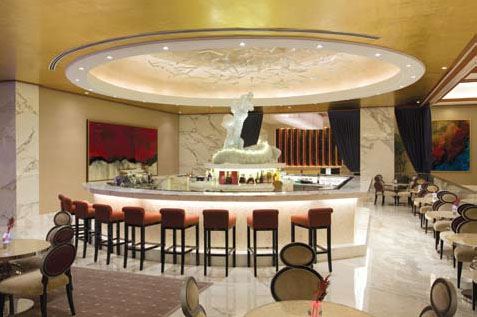
Dragon Bar
As befits a gambling joint, the food product is varied and elaborate. Wolfgang Fischer was lured from his post as executive chef of Emirates Palace in Abu Dhabi, reputedly the most expensive hotel in the world, to serve as culinary director. His goal, he has said, is nothing less than Michelin status, something no eatery in the Philippines has ever achieved, and he’s assembled an A-team of Chinese, Japanese and Western chefs to oversee gourmet rooms serving authentic Cantonese (Red Lantern), Japanese (Yakumi) and Italian fare (Finestra) and classic steaks and chops (STRIP). There is an international buffet, Fresh, a place called Lucky Noodles dishing up Asian comfort food in a casual setting, and what Solaire calls its “next generation food court” purveying Asian, Southeast Asian and American quick bites.
The executive team is one of extraordinary talent and experience and deserves mentioning in some detail. Mr Weidner ran Las Vegas Sands as chief operating officer from the planning of The Venetian on the Las Vegas Strip in the mid- ’90s through the establishment of LVS as a power in Macau. Mr Stone served directly under him as executive vice president during those years and later was LVS’ president of Global Operations & Construction. In charge on the ground in Manila are COO Michael French and Senior Vice President of Gaming Dennis Andreaci, both highly regarded LVS alumni, and Adrian Ort, who brings extensive Asian experience to the hotel side as vice president, Operations, and general manager. Mr French was a member of the opening team at Altira Macau and later served as senior vice president for Operations at City of Dreams. Mr Andreaci ran table games at The Venetian Macau and Marina Bay Sands in Singapore before moving to Galaxy Macau as senior vice president of Gaming Operations. Vice President, Business Development and VIP Services Lorraine Koo, a 15-year veteran of Singapore Airlines, also came to Solaire from Galaxy Macau. She was assistant vice president of Casino Customer Service.
‘Money To Go Around’
For years the Philippines market was the Philippines Amusement and Gaming Corporation, the government-owned operator and regulator whose 13 Casino Filipino-branded casinos and another 23 slot clubs comprise today a little over 7,100 slots and 650 table games. Three private operators have since joined the mix. Panama-based Thunderbird Resorts operates two similarly smallish casinos under its Fiesta brand in San Fernando City about 65 kilometers north of Manila and in Rizal, just east of the city. Macau’s Jimei Group, which over the years has run junkets, gambling cruises and travel and tour groups through the Philippines, operates Fontana Hot Spring Leisure Park in San Fernando City, featuring a casino, a golf course and family entertainment. Then in 2009 Resorts World Manila opened across from Terminal 3 of Ninoy Aquino International Airport, and everything changed, or certainly perceptions did. For as the property gradually ramped up to 1,800 slots and 300 tables and collected around itself 1,574 rooms and suites in three hotels and a 30,000-square-meter shopping mall with cinemas and dozens of restaurants, bars and fast-food outlets, Philippines gaming revenue doubled to nearly US$2 billion. Over its first full 18 months, from 1Q2010 to 3Q2011, average daily visitation went from 5,966 to 16,140, according to research compiled by CLSA Asia-Pacific Markets and quarterly EBITDA from $17.9 million to $59.6 million. The effect was to open investors’ eyes and those of the industry to the existence of a domestic market that is way more substantial both in numbers and in wherewithal than almost anyone was prepared to believe.
“I know they’re here. We’ve talked to them,” said Mr French. “They don’t like to play [in the Philippines] because they don’t like what’s available. If you’ve been to my competitors you see what I mean.”
The fact is, they were always there. Even in the years prior to Resorts World, total win per unit, tables and slots combined, always outstripped what were generally sluggish increases in total supply, by about two and half times between 2002 and 2008, compounded annually. Then came the dramatic increase in supply with Resorts World—mass tables increased by 26% between 2008 and 2010, slots by 17%—and Filipinos responded with alacrity. Mass market win per unit shot up 22%, slots by a whopping 127%.
“We view the Philippines as having a potentially larger domestic market in the high-margin mass segment compared to other Asian gaming hubs,” Credit Suisse said in initiating coverage of the local industry about three weeks before Solaire opened.
Mr French’s implication, of course, is that Resorts World Manila no longer has that market largely to itself.
“It’s a good thing,” said Mr Stone, “a good thing for all of us. I want to have good competitors, good properties that are going to help me out. It’s synergistic. And there’s enough money to go around for everybody we believe.”
Analysts agree. Credit Suisse is forecasting gaming revenue to grow at an annual rate of 28% through 2018, which is about double the rate for most of the Macau scenarios out there. The firm particularly likes the country’s “favorable demographics”— the sizable population (12th largest in the world) and the youth of it (27 is the average age, versus 28-41 elsewhere in the region), and the fact that it’s growing to working age faster than any emerging Asian economy’s. It’s also a workforce hailed worldwide for its friendliness and its service orientation, its high degree of adult literacy (96%), and the large component of it that speaks English.
Forecasts this year call for the national economy to grow at around 6.5%, which is especially meaningful for the gaming industry because it’s growth that is driven overwhelmingly by private consumption, which accounts for 70% of GDP. (In China, by way of contrast, it accounts for less than half.) Citigroup gaming analyst Michael Beer calls it a “phenomenal domestic consumption story”. Remittances by Filipinos working abroad will account for a significant portion of it. They comprise about 9% of the total economy and last year they hit a record US$23.8 billion, an increase of 6.4% year on year. This year they are expected to grow another 5%. In its analysis of how this trickles down to businesses like casinos, CLSA notes that Philippine households that would be characterized as middle-class, defined as annual disposable incomes of more than $5,000, are growing the fastest among all income brackets, and as per capita GDP has risen (by about 30% in the 10 years through 2011), so, too, has discretionary leisure expenditure as a percentage of total consumer spend—from 5.9% in 2001 to 6.7% in 2011.
Current plans for the supply at Entertainment City that will be chasing this pent-up demand include:
• Belle Grande Manila Bay—opening in 2Q14 with 1,900 slots and 350 tables and 1,092 hotel rooms together with nongaming amenities at a total projected cost of $1.3 billion. Melco Crown’s partner is Belle Corp., a subsidiary of retail giant SM Group, owner of Manila’s Mall of Asia. Belle is well-known in the country as a developer of high-end residential communities (some of which is planned for the Belle Grande complex) and country clubs.
• Resorts World Bayshore—this is the partnership between Genting Hong Kong (formerly Star Cruises) and Alliance Global Group that owns Resorts World Manila, Travellers International Hotel Group, it’s called. Opening is slated for 2016 with 2,040 slots, 360 tables and 1,440 rooms. Projected cost: $1.2 billion.
• Manila Bay Resorts—a partnership between the Philippines’ Robinsons Land and Tiger Resorts Leisure and Entertainment, a subsidiary of Universal Entertainment, which is controlled by Japanese machine gaming tycoon Kazuo Okada. Plans call for an opening after 2016 with 3,000 slots, 500 table games, 2,000 hotel rooms, an oceanarium, a sports arena and giant Ferris wheel. Total cost: $2 billion.
At some point about midway through all this development the size of the total gaming market is expected to grow to $3 billion, with Entertainment City contributing a little more than half. PAGCOR is looking for total revenue to hit $6 billion by 2015, —a “blue-sky scenario,” CLSA calls it, but not out of the question, the firm says.
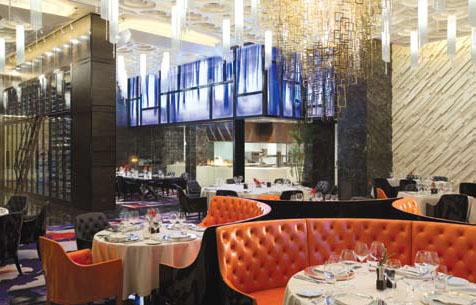
STRIP serves classic steaks and chops.
A lot will depend on the Philippines’ ability to address its notoriously poor road and public transportation infrastructure. This is a big deal in a country where the population is so widely dispersed and where government spends far less on infrastructure on average than other Asian countries. Just getting across Manila is an ordeal. Covering the 5 or 6 kilometers from Ninoy Aquino to Solaire can take 45 minutes or more by car. Construction of a flyover from the airport, bypassing the surface streets, is expected to be bid out this year. The “Skyway,” as it’s called, will be funded by the Entertainment City developers, who hope to see it completed by 2015.
Solaire, meanwhile, has 8 more hectares of land to work with and plenty more supply already taking shape on it. A $400 million Phase 1a, scheduled for completion in the second half of 2014, will include 300 hotel suites of 75 square meters and larger, about 5,600 square meters of retail, 1,400 square meters of convention and meeting space, a theater on a Broadway scale, world-class spa and fitness facilities, a pool, another 1,300 parking spaces and an expansive bay-front promenade.






